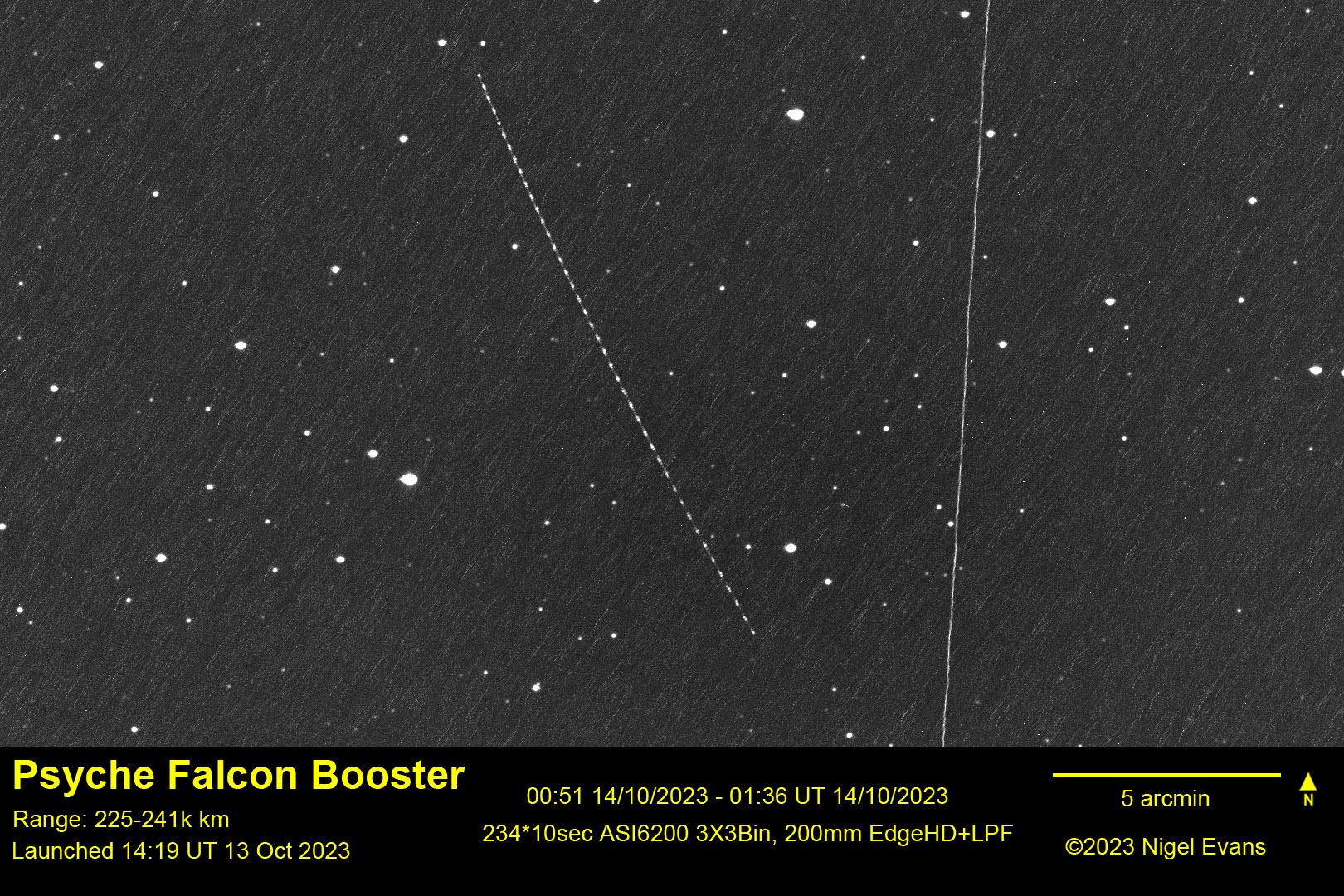
Orwell Astronomical Society (Ipswich)
Psyche, 14-15 October 2023
The long-awaited launch of NASA's Psyche probe, to explore asteroid (16) Psyche, provided another opportunity to record a distant man-made object. Launch of the probe was originally scheduled for 2022, but difficulties during development and test forced the date to be moved back, and it finally took place on 13 October 2023. A clear sky was forecast for the following morning in the UK. I used JPL Horizons to predict the location of the craft and hoped to record both the probe and its booster stage in the same field of view.
At the start of observation the probe was moving at an apparent rate of 16 arc-seconds/minute. At such a speed, a long exposure would result in the probe appearing as a streak, so I decided to use 10 second exposures and align subsequent frames on the probe to create a stronger image of it.
I hoped to find two moving objects in the images, but could only locate one. Psyche is a craft benefitting from three-axis stabilisation, so I expected a smooth, even trace across the sky. But the object flashed! The flashing object, with a period of approximatley 65 s, was almost certainly the booster rocket. As my exposures were much shorter than the period, I could assemble a movie from the frames. See the still image and movie following.
So, the booster was visible, at around magnitude 15.5, but where was the spacecraft? It was not obvious anywhere in the field of view. Had the two objects drifted apart so far since launch? By stacking all the images of the booster I was in for a surprise. The video below shows a movie version. Unfortunately, there was a slight mist of condensation on the camera that that had not quite cleared when I began capturing the images, and the processing has revealed it. The probe is likely the faint dot in the movie following.
I wondered if it was possible to show both the Psyche craft and booster rocket at the same time. The exposures were of 10 s duration, with an inter-exposure gap of approximately 1.5 s. I wanted to arrange the frames into a video showing the cycles of variation in brightness of the booster. But the 65 s period of the brightness of the booster did not correspond to an integral number of image frames. If the image frames were not selected for stacking in relation to their relationship to the light curve of the booster, the net result would be to smooth out the variation in brightness of the latter. However, every 5th or 6th frame showed the booster at its brightest, so I adopted the following approach. I grouped the frames into groups of seven, each centred on a frame with the booster at its brightest. This resulted in several instances where a frame showing the booster at its faintest appeared in two consecutive groups. I then stacked all the frames in position 1 of each group, all the frames in position 2 of each group, and so on. The seven resultant stacked frames form a short loop video showing the variation in brightness of the booster. In the following video, the loop is repeated four times.
After some 2½ hours, the motion of the probe through the sky reduced to around 5 arc-seconds/minute, enabling me to increase the exposure to 30 seconds. The image and movie below show the results: the probe is visible as a faint companion of the booster!
The following morning, 15 October, further clear weather provided another opportunity to follow the probe and its booster. The objects had moved further from Earth, and the Psyche probe was beyond the range of my equipment. The boster, at three times greater distance than the probe, was much fainter than on the previous day, but still visible, around magniture 17.5. See the image and video below.
Nigel Evans